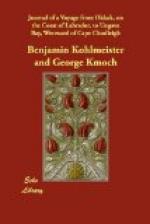23d. We set sail at sun-rise, but the wind being too high to suffer us to proceed with safety, we again anchored in a commodious harbour in Amitok island. Our people were here busily employed in repairing the damaged rigging and sails. Towards evening Jonas caught a seal, to the great gratification of our party. It was dressed immediately, and we joined them in their repast with a good appetite.
The Netsek is the only species of seal which remains during the winter under the ice. They form in it large caverns, in which they bring forth their young, two at a time, in March. More than one cavern belongs to one seal, that he may, if disturbed in the first, take shelter in the second. No other kind of seal is caught in winter by the Esquimaux.
24th. Brother Kmoch rose at two, and went on shore to examine the island more minutely. The morning was beautiful, and the sun rose with great splendour. Amitok lies N.W. from Kummaktorvik, is of an oblong shape, and stretches out pretty far towards the sea. The hills are of moderate height, the land is in many places flat, but in general destitute of grass. On the other side are some ruins of Greenland houses.
The Esquimaux have a tradition, that the Greenlanders came originally from Canada, and settled on the outermost islands of this coast, but never penetrated into the country, before they were driven eastward to Greenland. This report gains some credit, from the state in which the abovementioned ruins are found. They consist in remains of walls and graves, with a low stone enclosure round the tomb, covered with a slab of the same material. They have been discovered on islands near Nain, and though sparingly, all along the whole eastern coast, but we saw none in Ungava bay. The rocks on Amitok contain large masses of a crumbly, semi-transparent garnet, of a reddish hue. (From some specimens sent out, it rather appears to be a rose red quartz, or beryllite).
As it appeared as if we should be detained here, Brother Kmoch had made a fire, and was leisurely cooking a savoury mess of birds for breakfast, when Jonathan returned from the hills, with intelligence that the wind was abating in violence, and he therefore would proceed. The tent was struck, and all hurried on board: yet we had long to combat both an unfavourable wind and a strong current, which compelled us to double the East point of the island, and seek shelter among some small islands, steering for Niakungu point. From hence we got the first sight of Tikkerarsuk, (the Esquimaux name for a low point stretching from the continent into the sea), of the island Aulatzevik, and the high promontory of Kakkeviak. The whole country to the west of Niakungu is called Serliarutsit. It fell calm as we doubled the point, and we took to our oars, and came to an anchor in an open bay, south of Tikkerarsuk.




